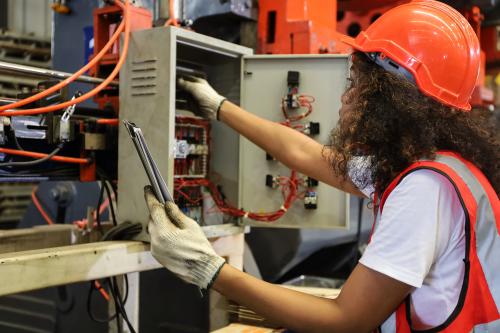Philadelphia is one of more than 800 municipalities across the United States working to reduce sewer overflows that occur when large storms flood and overwhelm infrastructure, resulting in a deluge of stormwater and diluted wastewater that can harm rivers and streams. While having more pristine waterways holds economic value, and complying with federal regulations to protect the environment helps ensure cleaner, higher-quality water, many cities are in a pinch: expanding wastewater treatment plants and centuries-old sewer systems is expensive, and outside dollars for water infrastructure are nonexistent.
In response, however, Philadelphia has embarked on a multi-generational, multi-billion-dollar program that is not only addressing stormwater runoff and sewer overflows, but providing new job opportunities, better preparing us for climate change, and creating neighborhoods that are greener, more vibrant places for our residents to live, learn, work and play.
Designed by the Philadelphia Water Department over the course of several years and formally adopted by Philadelphia and state and federal regulators in 2011, the 25-year Green City, Clean Waters program is using decentralized plant-and soil-based green infrastructure systems to keep excess stormwater out of sewers and reduce overflows.
A combination of public investment, retrofitting incentives, and new regulations crafted to encourage green stormwater management adoption in the private sector has resulted in hundreds of new green infrastructure systems in parks, parking lots, schoolyards and more. Those green tools are now capable of keeping 1.5 billion gallons of polluted water out of our rivers and creeks over the course of a typical year of Philadelphia weather.
As Philadelphia’s water becomes cleaner and our neighborhoods become greener, Green City, Clean Waters is helping to fuel our robust green jobs economy, attracting more innovative and environmentally-conscious companies. It’s also providing new opportunities for local small businesses owned by minorities, women and other communities not typically associated with large infrastructure projects.
Under a large-scale traditional infrastructure approach using centralized solutions, such as massive concrete stormwater storage tunnels and treatment plant expansions, construction contracts are typically awarded to national and even multinational firms. The most ambitious of these projects may result in a few hundred jobs, spread out over several years of construction.
With investment distributed across both decades and neighborhoods, the many smaller, decentralized projects that make up Green City, Clean Waters are creating new entry points for smaller, local firms to bid on and build green infrastructure. Additionally, green infrastructure creates a sustained demand for maintenance jobs requiring less education and technical expertise.
Both factors encourage local job gains and create more opportunities for minority and women-owned businesses. Being an early adopter in the still-evolving field of green infrastructure has also created a local demand for high-skill jobs in science and engineering.
Even with these advantages, training a local workforce to meet the long-term demand for green infrastructure maintenance remains a challenge. Providing the education and skills needed to succeed in a 21st century economy and improving economic opportunities for all Philadelphians are pillars of my administration, and programs like Green City, Clean Waters offer fertile ground to pursue those goals.
In addition to apprenticeship programs with local high schools, the Philadelphia Water Department and City of Philadelphia are using PowerCorpsPHL—an AmeriCorps program designed to support environmental stewardship and other initiatives—to train at-risk youth for green infrastructure maintenance jobs.
That collaboration has resulted in young Philadelphians, some who may have been incarcerated, now working as members of our green economy. We’re working to make stories like that more and more common.
The good news is that Green City, Clean Waters is set to expand dramatically in the coming years as we strive to meet ambitious greening and water quality targets. With that growth will come more demand for green jobs and more opportunities to connect with communities impacted by chronic unemployment. Consider that, by 2036, Philadelphia’s green stormwater infrastructure footprint is expected to grow more than tenfold.
Support for programs that would help Philadelphia make the most of this potential for a sizable green infrastructure economy would go a long way. Infrastructure funding from the federal government for water and other projects would create even more opportunities.
As is, all of Philadelphia’s water infrastructure investment is funded through the water bills that residents pay. In a city where a quarter of all adults live in poverty, though, that reality means we can only do so much.
Thanks to programs like Green City, Clean Waters, we’re primed to capitalize on an infusion of major infrastructure funding by making investments that create healthier neighborhoods, cleaner waterways and a solid green jobs workforce.
The City of Philadelphia’s Water Department is a public utility providing drinking water to 1.6 million customers and wastewater-stormwater services to 2.2 million people in the city and the surrounding suburbs. The department’s current fiscal year capital budget includes $68 million for the Green City, Clean Waters and Storm Flood Relief programs, including green infrastructure, stream restoration, and sewer upgrade investments.





Commentary
As green infrastructure pioneers, Philadelphia is primed for workforce development
May 15, 2017